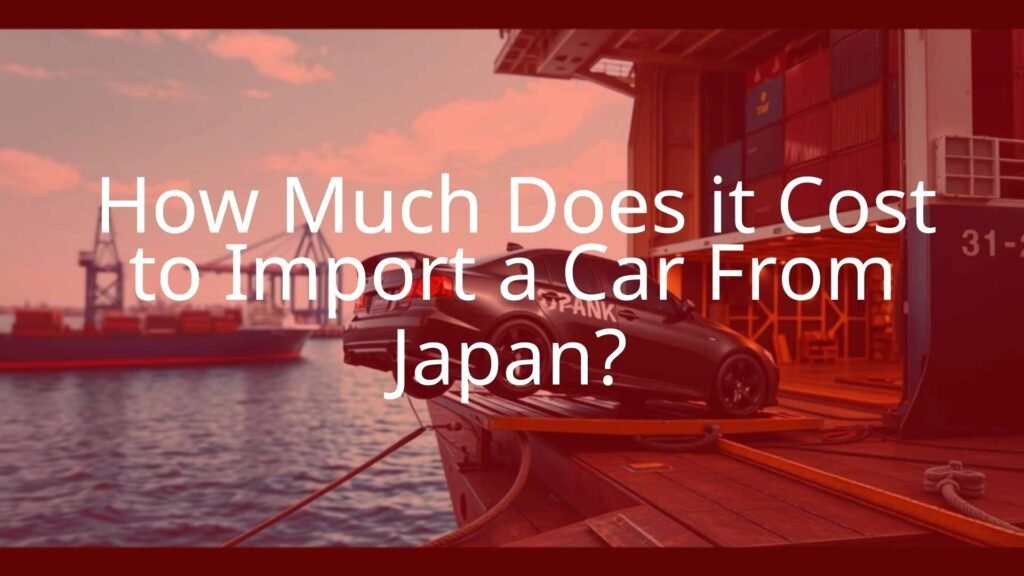Bringing a car from Japan to the United States is an appealing option for car fans and businesses, letting you access unique models and experience Japanese car culture. However, there are many costs involved beyond simply buying the car. Usually, the total cost to import a car from Japan is between $3,000 and $7,000, depending on the vehicle, shipping method, and your U.S. location. This guide will break down these expenses, giving you an easy-to-follow overview to help you prepare and avoid unexpected charges.
Knowing these costs before you start is key for budgeting and stopping surprise fees. Shipping, customs, local taxes, and any needed changes to meet regulations all add up. We’ll explain exactly where the money goes and how each part impacts your final bill when importing your dream car from Japan.

What Factors Decide the Cost of Importing a Japanese Car?
The cost to import a Japanese car changes based on several important things. These points affect both the price and how difficult or slow the process may become.
Type and Age of the Vehicle
The kind of car you choose plays a big part in the final cost. Big or heavy cars cost more to ship. More importantly, a car’s age affects how much you must spend to follow U.S. laws, especially with the “25-year rule.” Cars that are 25 years old or more don’t have to meet strict federal safety and emission requirements, making them easier and cheaper to import. Newer cars often need costly changes to pass these standards.
Also, different vehicle types face different import duties. Most passenger cars have a 2.5% duty added to their value, but pickup trucks pay a much higher 25% duty, often called the “Chicken Tax.” This means importing a Kei truck can be a lot pricier than importing a Kei car, even if they both cost about the same in Japan.
Where the Car Starts and Ends Up
Shipping costs depend on how far your car needs to travel from the Japanese port to your U.S. location. Ports like Yokohama, Tokyo, Nagoya, and Osaka are common starting points in Japan. If your car is already near these ports, inland transport in Japan is cheaper.
Your U.S. port of entry also matters. West Coast ports such as Los Angeles, Oakland, and Tacoma are cheaper to ship to ($1,200-$3,000), while East Coast ports like New York, New Jersey, and Baltimore are more expensive ($2,000-$4,200) due to longer shipping distances. Transport from the U.S. port to your address adds even more to the total cost.

Government Rules and If the Vehicle Qualifies
Understanding U.S. import rules is very important. Whether your car can legally enter affects paperwork, needed changes, and cost. The 25-year rule is a big help, letting older cars skip many modern requirements. Cars under 25 years old must meet EPA and DOT standards by filling out forms like 3520-1 and HS-7. Meeting these standards can mean paying specialists and spending more on required updates.
There are other rules, too. Cars must arrive with clean undersides (no foreign soil) to prevent pests, or you’ll pay extra for cleaning. Prepare all paperwork ahead of time (like the Japanese Export Certificate, commercial invoice, and bill of sale) to avoid delays and added costs.
Shipping Options and Their Costs
The way you ship your car is one of the biggest decisions, directly changing the total cost and delivery time.
Roll-on/Roll-off (RoRo)
Roll-on/Roll-off, or RoRo, is usually the cheapest way to ship a car. Cars are driven onto a special ship and off again at the destination. Costs are normally between $900 and $2,000 per vehicle. This method is simple, but only working cars can use RoRo and the cars must be empty. Your car is exposed during the trip, and these ships don’t always run on every route.
RoRo is best if you want to keep costs down and your car doesn’t need extra protection. Just remember, it’s not available for every type of car or every destination.
Container Shipping
Container shipping gives your car more protection. There are two main options:
- Shared Container: Your car shares space with other cars in one container. Costs for handling and unloading are split, saving you up to 50% compared to using a full container by yourself. This might take a bit longer as you have to wait for the container to fill, but it’s often worth the savings.
- Dedicated Container (20ft or 40ft): You get a whole container for your car (or multiple cars), which is more expensive but even safer and sometimes faster since you’re not waiting for others. A 20ft container fits one car; a 40ft container fits up to four (depending on their sizes).
Containers usually ship out every week from major Japanese ports. This method also allows you to pack personal items with the car.

Air Freight
Shipping your car by plane is very fast-delivery can take only 3-10 days. However, air freight is by far the most expensive option, costing $8,000-$16,000 per car. Air shipping is usually for rare, high-value, or time-sensitive vehicles. While it avoids delays and the risk of damage is lower, most people won’t use this method because of the high price.
Shipping Price Comparison
| Shipping Method | Typical Cost per Car | Details |
|---|---|---|
| Roll-on/Roll-off (RoRo) | $900-$2,000 | Cheapest, but exposed and only for running cars |
| Shared Container | $1,200-$2,500 | Good balance between cost and protection; longer wait to fill container |
| Dedicated Container | $1,800-$4,200 | Most secure; faster if not waiting on others; higher cost |
| Air Freight | $8,000-$16,000 | Very fast, very expensive |
Shipping to West Coast ports is cheaper ($1,200-$3,000); East Coast shipping is higher ($2,000-$4,200) due to greater distances.
How Ports Add to Japanese Car Import Costs
Ports add extra costs to your total bill. These aren’t just the shipping charges, but also handling fees, customs charges, and possible storage fees.
Port and Handling Fees
Once your car reaches a U.S. port, you’ll pay destination and handling fees, usually $500-$800 depending on the port. These cover unloading, moving the car around the port, and other basic services. These are required costs, so be sure to add them to your budget.
U.S. Customs charges a Harbor Maintenance Fee (HMF) of 0.125% of the car’s value, and a Merchandise Processing Fee (MPF) of 0.3464%. For example, a $10,000 car would be charged $12.50 for HMF and $34.64 for MPF (with a minimum MPF of $31.67 and a maximum of $614.35 in 2025).
If your car stays at the port past the allowed free days (usually a few days to a week, with some services offering up to 30 days), you pay about $10 per day in storage. If customs inspects your car, extra fees of $1,000-$2,000 may be added.
An experienced shipping agent who knows the process can help keep these extra costs down.

List of Import Fees and Taxes
On top of shipping and port costs, you must pay government taxes and fees, both federal and state.
U.S. Customs Duties
For most cars, the import duty is 2.5% of the car’s value. For pickup trucks, the duty is much higher at 25% due to the “Chicken Tax.” This makes some vehicle types much more expensive to import.
Other federal fees include:
- Harbor Maintenance Fee (HMF): 0.125% of value
- Merchandise Processing Fee (MPF): 0.3464% of value (min $31.67, max $614.35 in 2025)
Example: A $10,000 car pays about $297.14 total in federal charges.
State and Local Fees
After clearing customs, you must pay state taxes and registration fees. State sales tax varies and can add hundreds or thousands, depending on where you register your car. Some states have extra property, environmental, or other fees. Check with your local DMV before you start, so you know what to expect.
Environmental and Safety Requirements
For cars less than 25 years old, you’ll have to pay for tests or updates to meet U.S. emissions and safety standards. These updates can be expensive and may require a specialist to complete the work and sign off on it, plus you may need to post a bond worth 1.5 times your vehicle’s value.
The 25-year rule lets you skip these requirements if your car is old enough, saving you a lot of money and trouble.
The 25-Year Rule and Exemptions
The “25-year rule” means cars 25 years old or more from the manufacturing date don’t have to pass EPA or DOT rules. This makes importing classic Japanese cars much easier and cheaper. Some other small exemptions exist, like for U.S.-built cars returning after use overseas, but for most people, the 25-year rule is the major advantage.

Other Extra Costs to Keep in Mind
Besides the standard costs, here are other charges you may face:
Shipping Insurance
Standard car insurance usually doesn’t cover shipping damage. Shipping companies offer insurance for an extra fee, protecting your car from risks while it’s being shipped overseas. Without it, your payout if something goes wrong could be very low.
Transport in Japan
If the car isn’t right by the port, you’ll have to pay to move it from the seller to the port. This usually costs $200-$500.
U.S. Domestic Transport
After arrival, the car needs to get from the port to your home. Transport within the U.S. costs $300-$1,200, depending on distance and type (open or enclosed trailer). Enclosed is more expensive but safer, especially for valuable vehicles.
Cleaning, Storage, and Documents
Your car’s underside must be cleaned to remove any dirt. If not done before shipping, you’ll pay extra to have it washed at the port. Storage charges apply if paperwork or pickup is delayed. You’ll also pay for document processing, translations, and possibly for auction or dealer fees if you bought your car at a Japanese auction. Some people also pay for a pre-shipment inspection for peace of mind.
Special Costs for Kei Cars and Classic Imports
Kei cars and classic vehicles have some price differences that you should know about.
Kei Car Imports
Kei cars are small and cheaper to ship because they take up less room. However, Kei cars (for personal use) get the standard 2.5% import duty, but Kei trucks (classed as pickups) are hit with the 25% rate, making trucks much more expensive to bring in. Kei vehicles usually cost less to buy, are fuel efficient, and are easy to move around cities.
Classic Cars
Cars 25 years or older avoid most expensive safety and emissions tests, making them much cheaper and easier to import. This helps explain why older Japanese models like the Nissan Skyline GT-R are so popular to import once they become eligible. However, sometimes rare or historic cars have special paperwork or “Show and Display” rules that limit their use.

How to Cut Down Japanese Car Import Costs
Here are some tips to help you spend less on your import:
Using a shared (consolidated) container means splitting costs with others, making shipping much cheaper than booking an entire container alone. You might wait a bit longer, but the savings can be significant, sometimes up to 50%.
Choose Your Port Wisely
Shipping to West Coast ports is usually cheapest from Japan. Even if you’re not local, it can be cheaper to ship to California and move the car cross-country than paying direct East Coast ocean freight. Check the numbers before deciding.
Work with Trustworthy Import Agents
Using an experienced agent helps you avoid mistakes, delays, and hidden charges. They know what forms you need, how to avoid extra fees, and can help you follow all laws. They may charge a service fee, but in most cases, they save you much more than they cost.
Example Costs: What to Expect
Here are two sample scenarios to show what importing a car might cost you:
Importing a Nissan Skyline GT-R (Classic)
- Car Price: $30,000
- Shipping Method: Container to Los Angeles
- Shipping Cost: $1,800
- Import Duties/Fees: $900 (2.5% of $30,000 plus HMF/MPF)
- Port Charges: $600
- U.S. Transport to Home: $500
- Total Extra Cost: $3,800
Total cost = $33,800 (plus state registration and taxes). The 25-year rule saves you a lot on compliance costs here.
Importing a Suzuki Cappuccino (Kei Car)
- Car Price: $8,000
- Shipping Method: Shared container to New York
- Shipping Cost: $2,200
- Import Duties/Fees: $240 (2.5% of $8,000 plus HMF/MPF)
- Port Charges: $750
- U.S. Transport to Home: $900
- Total Extra Cost: $4,090
Total cost = $12,090 (plus state registration and taxes). Notice how shipping to the East Coast raises the costs, even for a lower-priced car.
With careful planning and understanding each step, you can keep control over your import costs and make your Japanese car import a success.
- What Is a Maiko? - July 13, 2025
- What Does Domo Arigato Mean? - July 12, 2025
- What Does Naruto Mean? - July 12, 2025









